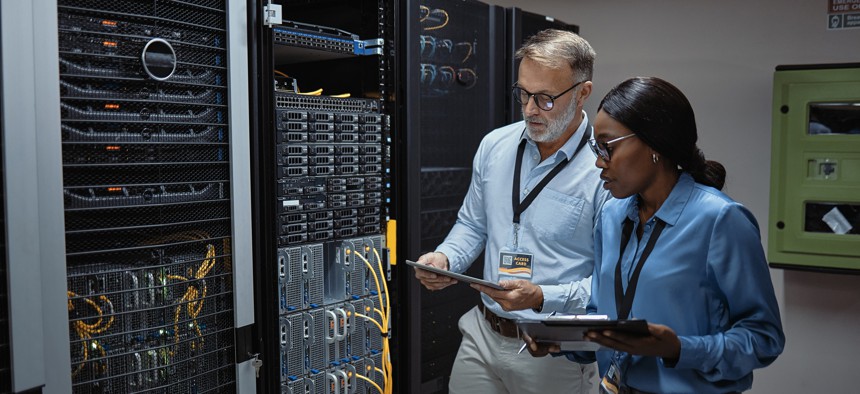How effective asset management supports data center sustainability

Marco VDM/Getty Images
COMMENTARY | With proactive monitoring and asset management, agencies can drive down cooling costs while avoiding downtime risk.
One of the biggest culprits of climate waste for government agencies is the data center, as power and cooling continue to be the largest cost centers within enterprise data centers today. The world’s ever-increasing connectivity is propelling demand for data center services and energy use (mostly electricity), with multiplying effects. As we trend toward a decentralized world full of hybrid and remote workers, automation, artificial intelligence and internet-of-things technology will increase data center efficiency, which directly impacts sustainability.
There are plenty of variables in the sustainability equation, but driving down cooling costs while avoiding risk is key. Data center managers can raise set points for HVAC, ensure server fans don’t spin up too much and use open air cooling while protecting against environmental challenges with temp and humidity. But delivering on each of them can be a bear as they’re inextricably linked to assets are being managed—or mismanaged.
3 steps to support sustainability in the data center
Any sustainability effort must be comprehensive, and an excellent place to start is with asset management best practices. Data center managers should create a plan to remove power-hungry assets and replace them with newer or recycled green assets. They should track conversion processes in real-time and automatically update both financial and asset management systems. However, making these changes wholesale without proper monitoring is a very risky endeavor. Without benchmarking and data monitoring, success cannot be tracked.
To that end, here are three key phases to implementing sustainability best practices:
- Establish a baseline. Before moving forward with a sustainability plan, data center managers must establish a starting point. They can determine a data center’s current carbon footprint by tracking direct emissions, data center energy consumption and e-waste. Dynamic resource monitoring tools, such as data center infrastructure management solutions are very helpful in understanding current state and measuring progress toward goals.
- Set targets and metrics. Determining what’s material to the agency’s data center sustainability strategy is key. Data center managers can apply materiality to pinpoint the issues they wish to prioritize—such as waste, water, energy and emissions. Operating a sustainable data center is a marathon, not a sprint, so it’s better to set bite-sized milestones than trying to overhaul an entire strategy overnight.
- Optimize operations and infrastructure. Now it’s time to blend these best practices and frameworks with others to drive agency- and industry-wide sustainability. Managers should build out a checklist that includes necessary actions and measures to govern every aspect of the sustainability strategy to identify corresponding solutions that track, monitor and report on agency efforts.
Mapping out ways to address specific environmental issues
Real-time, data-driven solutions are at the forefront of helping organizations reduce costs, cut power usage and meet environmental KPIs. Monitoring tools also relay critical information on the genesis of a specific problem within the data center, which allows staff to find a solution before downtime happens.
Let’s say an asset environmental monitoring system indicates that cooling systems are the culprit and a weak point in the sustainability campaign. In this case, actionable steps to take can include:
- Leverage air economizers. If the data center is in a colder region, agencies can use the naturally cool ambient air to keep temperatures inside the data center sustainable. In North America, between 40% and 90% of cooling can come from outside via air economizers, according to Gartner.
- Recycle and redistribute heat Some equipment in the data center runs hot. Instead of heating other parts of the building with oil or electric heating devices, facilities can funnel heat from the hot-running equipment throughout the building.
- Optimize air conditioning. Agencies that are unable to leverage naturally cold air can still optimize their current AC setup. One option is having it turn off at various intervals, especially when the morning and evening air is naturally cooler. Managers can also adjust the AC speed until they identify the optimal setting that will still reduce energy consumption.
The benefits of real-time monitoring of data center conditions simply cannot be understated. It’s critical that agencies work to bridge the gap between the demands of data centers and efficiency and sustainability goals. Improving energy efficiency and increasing sustainability isn’t a one-time project, it’s an ongoing commitment. With proactive monitoring and asset management, IT staff at data centers will be able to make better decisions—not only to meet sustainability KPIs, but also to understand the nuances of each asset and how they can ultimately benefit the entire organization.
Dale Quayle is CEO of RF Code.





